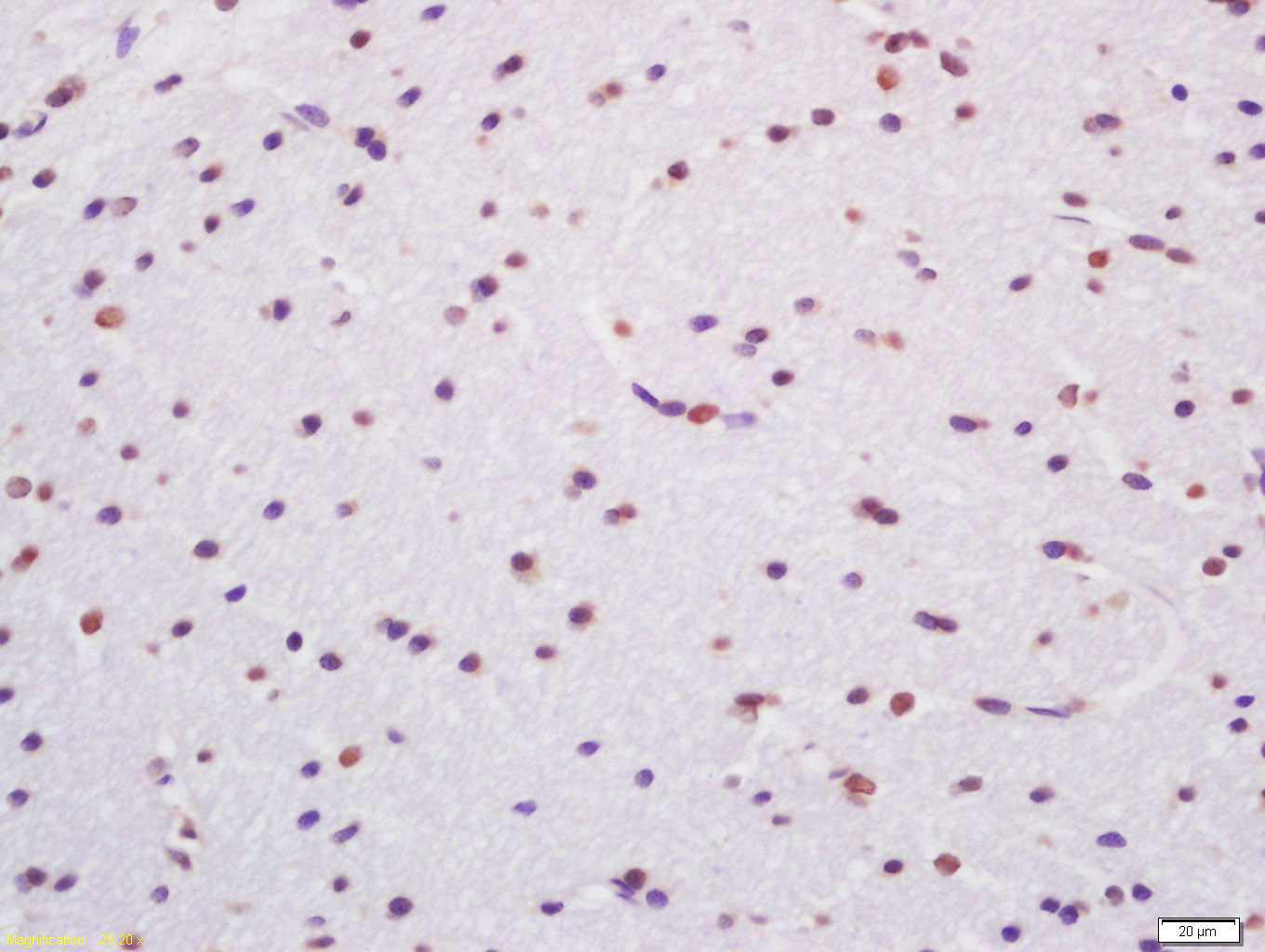
Rabbit Anti-TARDBP antibody
TAR DNA-binding protein 43; TAR DNA binding protein 43; ALS10; OTTHUMP00000002171; TAR DNA binding protein 43; TAR DNA binding protein; TDP 43; TDP-43; TDP43; tar DNA binding protein; ALS10; TADBP_HUMAN.
View History [Clear]
Details
Product Name TARDBP Chinese Name Tar DNA Binding protein43/TDP-43抗体 Alias TAR DNA-binding protein 43; TAR DNA binding protein 43; ALS10; OTTHUMP00000002171; TAR DNA binding protein 43; TAR DNA binding protein; TDP 43; TDP-43; TDP43; tar DNA binding protein; ALS10; TADBP_HUMAN. Research Area Neurobiology Signal transduction Bacteria and viruses Epigenetics Immunogen Species Rabbit Clonality Polyclonal React Species Rat, (predicted: Human, Mouse, Chicken, Cow, Rabbit, ) Applications ELISA=1:5000-10000 IHC-P=1:100-500 IHC-F=1:100-500 IF=1:100-500 (Paraffin sections need antigen repair)
not yet tested in other applications.
optimal dilutions/concentrations should be determined by the end user.Theoretical molecular weight 45kDa Cellular localization The nucleus Form Liquid Concentration 1mg/ml immunogen KLH conjugated synthetic peptide derived from human TDP-43: 21-120/414 Lsotype IgG Purification affinity purified by Protein A Buffer Solution 0.01M TBS(pH7.4) with 1% BSA, 0.03% Proclin300 and 50% Glycerol. Storage Shipped at 4℃. Store at -20 °C for one year. Avoid repeated freeze/thaw cycles. Attention This product as supplied is intended for research use only, not for use in human, therapeutic or diagnostic applications. PubMed PubMed Product Detail HIV-1, the causative agent of acquired immunodeficiency syndrome (AIDS), contains an RNA genome that produces a chromosomally integrated DNA during the replicative cycle. Activation of HIV-1 gene expression by the transactivator Tat is dependent on an RNA regulatory element (TAR) located downstream of the transcription initiation site. The protein encoded by this gene is a transcriptional repressor that binds to chromosomally integrated TAR DNA and represses HIV-1 transcription. In addition, this protein regulates alternate splicing of the CFTR gene. A similar pseudogene is present on chromosome 20. [provided by RefSeq, Jul 2008]
Function:
DNA and RNA-binding protein which regulates transcription and splicing. Involved in the regulation of CFTR splicing. It promotes CFTR exon 9 skipping by binding to the UG repeated motifs in the polymorphic region near the 3'-splice site of this exon. The resulting aberrant splicing is associated with pathological features typical of cystic fibrosis. May also be involved in microRNA biogenesis, apoptosis and cell division. Can repress HIV-1 transcription by binding to the HIV-1 long terminal repeat. Stabilizes the low molecular weight neurofilament (NFL) mRNA through a direct interaction with the 3' UTR.
Subcellular Location:
Nucleus. In patients with frontotemporal lobar degeneration and amyotrophic lateral sclerosis, it is absent from the nucleus of affected neurons but it is the primary component of cytoplasmic ubiquitin-positive inclusion bodies.
Tissue Specificity:
Ubiquitously expressed. In particular, expression is high in pancreas, placenta, lung, genital tract and spleen.
Post-translational modifications:
Hyperphosphorylated in hippocampus, neocortex, and spinal cord from individuals affected with ALS and FTLDU.
Ubiquitinated in hippocampus, neocortex, and spinal cord from individuals affected with ALS and FTLDU.
Cleaved to generate C-terminal fragments in hippocampus, neocortex, and spinal cord from individuals affected with ALS and FTLDU.
DISEASE:
Defects in TARDBP are the cause of amyotrophic lateral sclerosis type 10 (ALS10) [MIM:612069]. ALS is a neurodegenerative disorder affecting upper and lower motor neurons and resulting in fatal paralysis. Sensory abnormalities are absent. Death usually occurs within 2 to 5 years. The etiology of ALS is likely to be multifactorial, involving both genetic and environmental factors. The disease is inherited in 5-10% of the cases.
Similarity:
Contains 2 RRM (RNA recognition motif) domains.
SWISS:
Q13148
Gene ID:
23435
Database links:Entrez Gene: 23435 Human
Entrez Gene: 230908 Mouse
Omim: 605078 Human
SwissProt: Q13148 Human
SwissProt: Q921F2 Mouse
Unigene: 300624 Human
Unigene: 635053 Human
Unigene: 22453 Mouse
Unigene: 2633 Rat
变异蛋白质TDP-43 在额颞叶退行性病变(FTLD-U)和萎缩性侧索硬化症(ALS)中表达较高。TDP-43在大脑中堆积能导致神经细胞衰竭,从而引发疾病肌萎缩性侧索硬化(ALS,也被称为Lou Gehrig氏病)
TDP-43这种痴呆是由大脑额叶的退化引起的,退化能延伸到颞叶。这是仅次于阿尔默海兹症的让65岁以下患者痴呆的第二种最常见的原因,通常影响40几岁和50几岁的人。TDP-43过去在神经退化疾病患者病理的错误折叠蛋白中缺失。识别出这个蛋白应该有助于痴呆以及运动神经元疾病的研究。Product Picture
Antigen retrieval: citrate buffer ( 0.01M, pH 6.0 ), Boiling bathing for 15min; Block endogenous peroxidase by 3% Hydrogen peroxide for 30min; Blocking buffer (normal goat serum,C-0005) at 37℃ for 20 min;
Incubation: Anti-TARDBP Polyclonal Antibody, Unconjugated(SL0822R) 1:200, overnight at 4°C, followed by conjugation to the secondary antibody(SP-0023) and DAB(C-0010) staining
Bought notes(bought amounts latest0)
No one bought this product
User Comment(Total0User Comment Num)
- No comment



 +86 571 56623320
+86 571 56623320
 +86 18668110335
+86 18668110335

